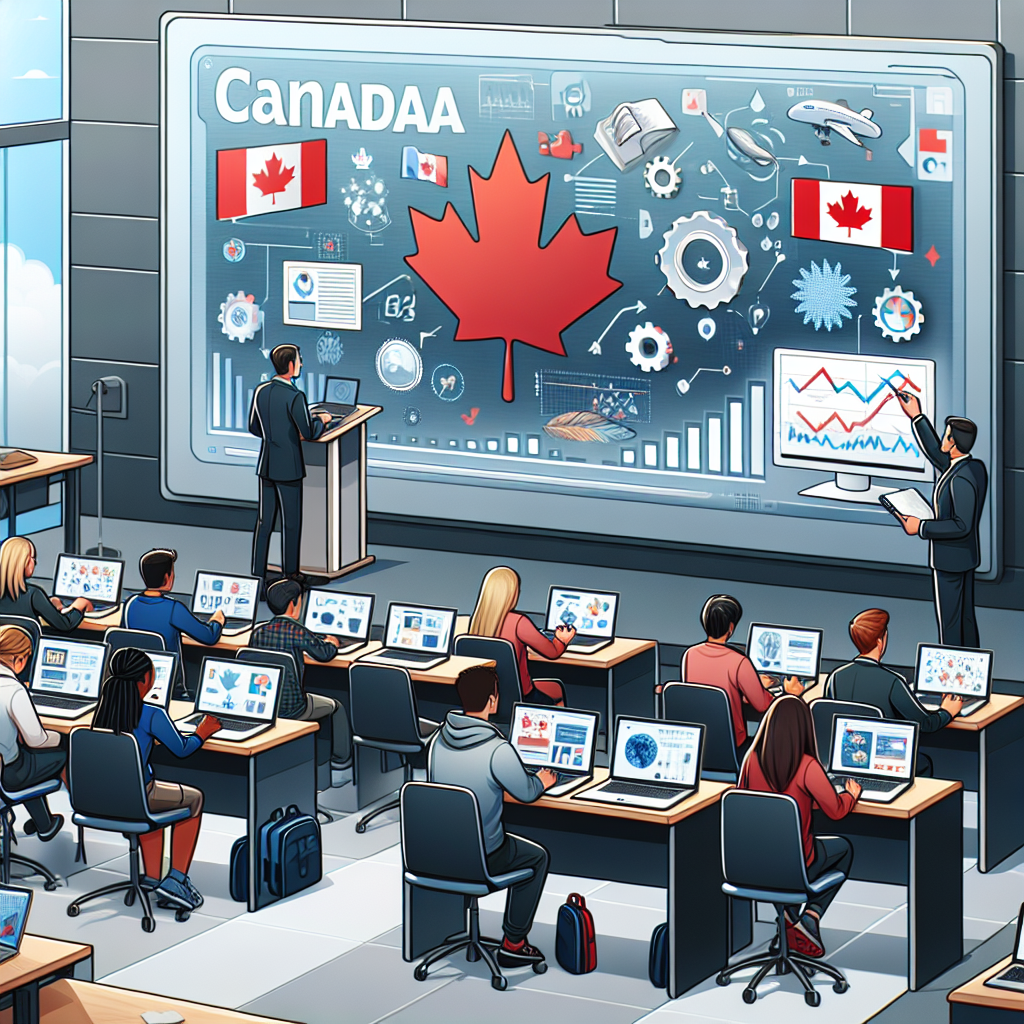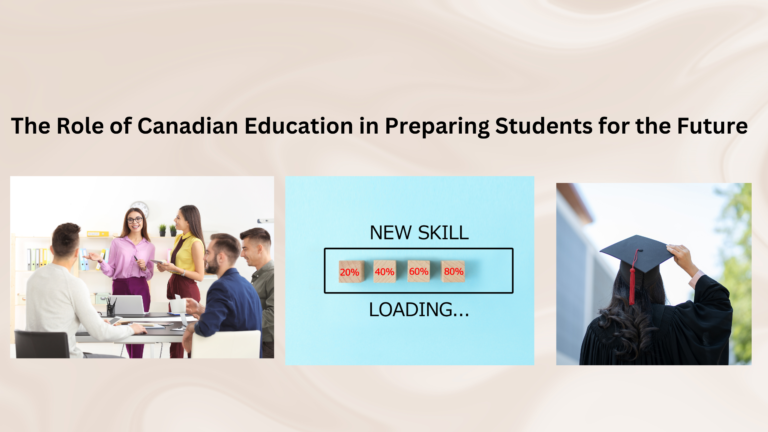Canada’s Shift Towards Modern Education
# Canada’s Shift Towards Modern Education
Education is the cornerstone of a progressive society, and Canada is no stranger to embracing change for the betterment of its future generations. As the world evolves, so too must the systems and methods we use to educate our youth. Canadian schools are at the forefront of this transformation, implementing education reforms that are setting new standards for teaching and learning in the 21st century. In this article, we will delve into the various education system changes in Canada and how they are shaping the future of learning.
Embracing a Holistic Approach to Learning
The Canadian education system is increasingly recognizing the importance of a holistic approach to education. This means going beyond traditional academic subjects and incorporating social, emotional, and physical development into the curriculum.
Social and Emotional Learning (SEL)
SEL has become a key component of modern education, teaching students essential life skills such as empathy, self-awareness, and conflict resolution. By integrating SEL into the curriculum, Canadian schools are helping students to better understand and manage their emotions, set and achieve positive goals, and establish and maintain positive relationships.
Physical Education and Health
Physical education is no longer just about playing sports; it now includes a broader focus on health and well-being. Schools are encouraging healthy habits, such as regular exercise, proper nutrition, and mental health awareness, to ensure that students are well-rounded and ready to face the challenges of the modern world.

Leveraging Technology in the Classroom
Technology has become an integral part of education reforms in Canada. Digital tools and resources are being used to enhance learning experiences and prepare students for a rapidly changing digital world.
Interactive Learning Environments
Interactive whiteboards, tablets, and online learning platforms are just a few examples of the technology being integrated into Canadian classrooms. These tools not only make learning more engaging but also cater to different learning styles and paces, ensuring that every student can thrive.
Preparing for the Digital Economy
As the job market increasingly demands digital literacy, Canadian schools are equipping students with the skills they need to succeed. Coding, digital media, and information technology are now part of the curriculum, providing students with a head start in the competitive global economy.

Curriculum Reforms for a Changing World
The curriculum in Canadian schools is undergoing significant changes to reflect the needs of a modern society. Subjects are being updated, and new ones are being introduced to give students a comprehensive and relevant education.
Emphasis on STEAM Subjects
Science, Technology, Engineering, Arts, and Mathematics (STEAM) subjects are receiving more focus, reflecting their importance in today’s innovation-driven landscape. By integrating arts into STEM subjects, students are encouraged to use their creativity alongside technical skills, fostering a well-rounded approach to problem-solving.
Indigenous Education
Canada’s commitment to reconciliation with Indigenous peoples is reflected in the education system. Schools are incorporating Indigenous perspectives, histories, and knowledge into the curriculum, promoting understanding and respect for Canada’s First Nations, Métis, and Inuit communities.
Environmental Education
With environmental concerns becoming increasingly pressing, Canadian schools are teaching students about sustainability and ecological responsibility. This includes both classroom learning and hands-on activities, such as school gardens and recycling programs, to instill a sense of stewardship for the planet.
Fostering Inclusivity and Diversity
Inclusivity and diversity are core values in Canada, and the education system is working to ensure that these principles are reflected in schools. From inclusive curriculums to support for students with diverse needs, Canadian education is becoming more accommodating and representative of its multicultural society.
Inclusive Curriculums
Educational materials and lesson plans are being developed to reflect the diverse backgrounds and experiences of students. This includes not only cultural representation but also different learning abilities, ensuring that all students feel seen and supported in their educational journey.
Support for Diverse Learning Needs
Specialized programs and resources are available for students with disabilities, learning differences, and those who require additional support. By tailoring educational approaches to meet the needs of each student, Canadian schools are promoting equity and opportunity for all.
Professional Development for Educators
For education reforms to be successful, teachers must be equipped with the knowledge and tools to implement them effectively. Professional development is a key focus in Canada, with ongoing training and support for educators.
Training in New Pedagogies
Teachers are receiving training in new teaching methods and pedagogies that align with modern educational practices. This includes differentiated instruction, collaborative learning, and assessment strategies that accurately reflect student learning and progress.
Access to Resources and Support
Educators have access to a wealth of resources, from teaching materials to professional learning communities, that support their growth and development. By investing in educators, Canada is ensuring that its students are receiving high-quality instruction from knowledgeable and skilled teachers.
The Road Ahead: Continuous Improvement
The shift towards modern education in Canada is an ongoing process. Continuous evaluation and improvement are necessary to ensure that the education system remains responsive to the needs of students and the demands of the world they will inherit.
Adapting to Future Challenges
As society and technology continue to evolve, so too must the education system. Canadian schools are committed to staying ahead of the curve, adapting to new challenges, and preparing students for an uncertain but exciting future.
Engaging the Community
Parents, guardians, and community members are important partners in education. Schools are fostering stronger connections with the community to support student learning and well-being, recognizing that education is a collaborative effort.

Conclusion
Canada’s shift towards modern education is a testament to the country’s dedication to preparing its youth for a bright and prosperous future. Through holistic approaches, technology integration, curriculum reforms, inclusivity efforts, and professional development for educators, Canadian schools are creating an environment where every student can succeed. As we look to the future, it is clear that Canada’s education system will continue to evolve and serve as a model for progressive and effective learning worldwide.
# Canada’s Shift Towards Modern Education
Education is the cornerstone of a progressive society, and Canada is no stranger to embracing change for the betterment of its future generations. As the world evolves, so too must the systems and methods we use to educate our youth. Canadian schools are at the forefront of this transformation, implementing education reforms that are setting new standards for teaching and learning in the 21st century. In this article, we will delve into the various education system changes in Canada and how they are shaping the future of learning.
Embracing a Holistic Approach to Learning
The Canadian education system is increasingly recognizing the importance of a holistic approach to education. This means going beyond traditional academic subjects and incorporating social, emotional, and physical development into the curriculum.
Social and Emotional Learning (SEL)
SEL has become a key component of modern education, teaching students essential life skills such as empathy, self-awareness, and conflict resolution. By integrating SEL into the curriculum, Canadian schools are helping students to better understand and manage their emotions, set and achieve positive goals, and establish and maintain positive relationships.
Physical Education and Health
Physical education is no longer just about playing sports; it now includes a broader focus on health and well-being. Schools are encouraging healthy habits, such as regular exercise, proper nutrition, and mental health awareness, to ensure that students are well-rounded and ready to face the challenges of the modern world.
Leveraging Technology in the Classroom
Technology has become an integral part of education reforms in Canada. Digital tools and resources are being used to enhance learning experiences and prepare students for a rapidly changing digital world.
Interactive Learning Environments
Interactive whiteboards, tablets, and online learning platforms are just a few examples of the technology being integrated into Canadian classrooms. These tools not only make learning more engaging but also cater to different learning styles and paces, ensuring that every student can thrive.
Preparing for the Digital Economy
As the job market increasingly demands digital literacy, Canadian schools are equipping students with the skills they need to succeed. Coding, digital media, and information technology are now part of the curriculum, providing students with a head start in the competitive global economy.
Curriculum Reforms for a Changing World
The curriculum in Canadian schools is undergoing significant changes to reflect the needs of a modern society. Subjects are being updated, and new ones are being introduced to give students a comprehensive and relevant education.
Emphasis on STEAM Subjects
Science, Technology, Engineering, Arts, and Mathematics (STEAM) subjects are receiving more focus, reflecting their importance in today’s innovation-driven landscape. By integrating arts into STEM subjects, students are encouraged to use their creativity alongside technical skills, fostering a well-rounded approach to problem-solving.
Indigenous Education
Canada’s commitment to reconciliation with Indigenous peoples is reflected in the education system. Schools are incorporating Indigenous perspectives, histories, and knowledge into the curriculum, promoting understanding and respect for Canada’s First Nations, Métis, and Inuit communities.
Environmental Education
With environmental concerns becoming increasingly pressing, Canadian schools are teaching students about sustainability and ecological responsibility. This includes both classroom learning and hands-on activities, such as school gardens and recycling programs, to instill a sense of stewardship for the planet.
Fostering Inclusivity and Diversity
Inclusivity and diversity are core values in Canada, and the education system is working to ensure that these principles are reflected in schools. From inclusive curriculums to support for students with diverse needs, Canadian education is becoming more accommodating and representative of its multicultural society.
Inclusive Curriculums
Educational materials and lesson plans are being developed to reflect the diverse backgrounds and experiences of students. This includes not only cultural representation but also different learning abilities, ensuring that all students feel seen and supported in their educational journey.
Support for Diverse Learning Needs
Specialized programs and resources are available for students with disabilities, learning differences, and those who require additional support. By tailoring educational approaches to meet the needs of each student, Canadian schools are promoting equity and opportunity for all.
Professional Development for Educators
For education reforms to be successful, teachers must be equipped with the knowledge and tools to implement them effectively. Professional development is a key focus in Canada, with ongoing training and support for educators.
Training in New Pedagogies
Teachers are receiving training in new teaching methods and pedagogies that align with modern educational practices. This includes differentiated instruction, collaborative learning, and assessment strategies that accurately reflect student learning and progress.
Access to Resources and Support
Educators have access to a wealth of resources, from teaching materials to professional learning communities, that support their growth and development. By investing in educators, Canada is ensuring that its students are receiving high-quality instruction from knowledgeable and skilled teachers.
The Road Ahead: Continuous Improvement
The shift towards modern education in Canada is an ongoing process. Continuous evaluation and improvement are necessary to ensure that the education system remains responsive to the needs of students and the demands of the world they will inherit.
Adapting to Future Challenges
As society and technology continue to evolve, so too must the education system. Canadian schools are committed to staying ahead of the curve, adapting to new challenges, and preparing students for an uncertain but exciting future.
Engaging the Community
Parents, guardians, and community members are important partners in education. Schools are fostering stronger connections with the community to support student learning and well-being, recognizing that education is a collaborative effort.
Conclusion
Canada’s shift towards modern education is a testament to the country’s dedication to preparing its youth for a bright and prosperous future. Through holistic approaches, technology integration, curriculum reforms, inclusivity efforts, and professional development for educators, Canadian schools are creating an environment where every student can succeed. As we look to the future, it is clear that Canada’s education system will continue to evolve and serve as a model for progressive and effective learning worldwide.







